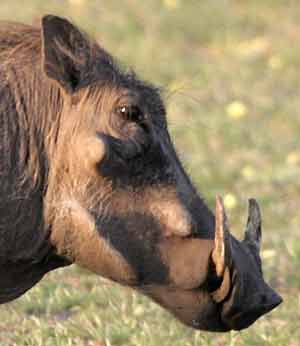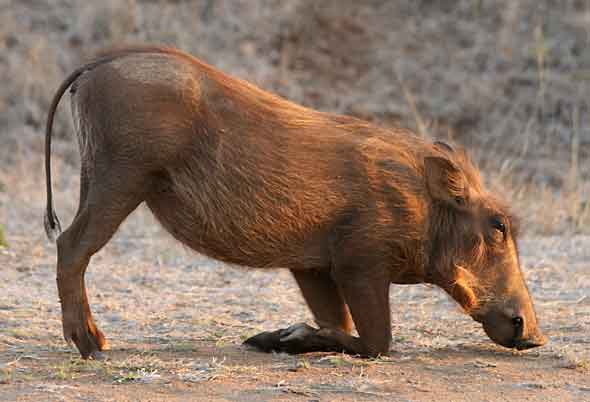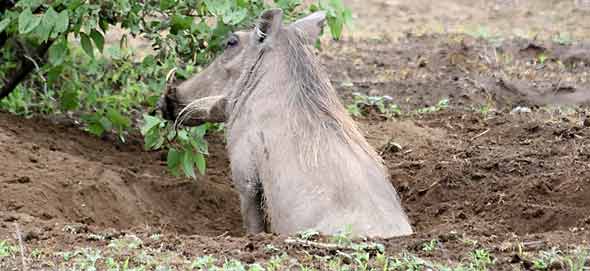Contact Details: Scotch Macaskill, Dirt Road Traders, Currys Post Road, Howick, KwaZulu-Natal, South Africa. Tel: +27 (0)82 578 2329. Privacy: Your privacy is guaranteed. See our Privacy Policy for more. This site accepts advertising and other forms of compensation - see Disclosure and Advertising for details. Site updated: 2022. Copyright © 2002 - 2022 Scotch Macaskill

| ||||||||||
|
||||||||||
|
SEE ALL
|
How the Warthog got its Name and Other Interesting Warthog Factsby Roddy SmithIt is a measure of the iconic status of this small and (let's be honest here) astonishingly ugly pig that one of the world's most fearsome combat aircraft is generally known, not by its official name of Thunderbolt, but as the Warthog.
Warthogs (Phacochoerus africanus) get their English name from the large wart-like protuberances on their faces, which are also a way of telling male from female. Males have two prominent pairs of "warts" - a large one beneath each eye and one on each cheek, while females have only a much smaller pair beneath the eyes. These warts and their upper tusks distinguish warthogs from their relations, the bushpigs (Potamochoerus larvatus); a warthog's upper tushes are adapted canine teeth whch grow throughout its life. However, although the upper tusks look impressive, it is the shorter lower tusks honed to razor sharp edges by rubbing against the upper ones, which are the real weapons. Warthogs also differ markedly in their behaviour from bushpigs, partly because of their different habitats. Warthogs are generally animals of the savannah; bushpigs favour dense bush and forest. Warthogs are strictly diurnal while bushpigs are largely nocturnal; this may be because warthogs would be very vulnerable to predators in open savannah at night. Predominanty Grass EatersBushpigs are more genuinely omnivorous; warthogs are predominantly eaters of grass and grass roots, although they will readily eat sedges, herbs and fruit.They are of course pigs, however, and will eat pretty much anything if they have to; there are authenticated reports of them eating carrion and killing and eating snakes, although this is probably not typical behaviour. A colleague of mine was once asked by overseas tourists what warthogs hunt; he replied - correctly -that they don't, but was also unwise enough to make fun of the suggestion. Inevitably, later on the same game drive they came across warthogs feeding off a carcass, and his clients thereafter regarded him with great scepticism. Warthogs prefer to eat short grasses and especially those growing in damp places, which are more succulent. As the season wears on and grass is in short supply, they spend most of the day rooting for rhizomes (grass roots) using the hard cartilaginous disc on the end of their noses. They kneel down to do this and consequently are able to root in hard, sun-baked ground much more effectively than bushpigs, and develop large callouses on their front "knees" as a result.
The warthogs' well-known habit of running with their tail stuck straight up in the air is also probably an adaptation to their grassland environment; in the rainy season, when the grass is long, it enables families or groups to see and follow each other. The basic unit of warthog social life is the matriarchal group (groups are called sounders) comprising one or occasionally more adult females and their young. Offspring, especially females, may stay with their mother for up to 27 months, but usually the previous year's young will leave to form yearling groups when the mother farrows again. Later, the males may form bachelor groups, but when they reach full maturity they are generally solitary, although a male may live temporarily with a group containing a female in oestrous. Joyously PromiscuousUnlike bushpigs, which live in permanent groups comprising a male and his harem, warthogs are joyously promiscuous and have no permanent ties.Warthogs are not territorial, but do have home ranges, frequently overlapping those of other groups. Within the home range they will have a number of burrows and will move from one to another. These are usually dug by aardvarks and then adapted by warthogs. They may also use erosion gullies. Their holes are very important to them: because their sparse hair is virtually no use as insulation and they have almost no sub-cutaneous fat, warthogs are very vulnerable to extremes of temperature and in cold weather remain huddled in their holes for warmth.
They are also a refuge from predators: the mother, or the male if one is with the group, usually backs into the burrow and sleeps facing the entrance. When running for cover, the young warthogs dive head-first down the hole; the parent does a fast hand-brake turn at the last moment and slides in facing outwards. This is not much help against lions, which dig them out when desperate, but they can repel most other predators and the warthogs usually sit tight until they have gone. It is nevertheless not a good idea to stand peering down a warthog hole; it might be one that believes that attack is the best form of defence. Roddy Smith is a wildlife conservationist and safari guide based at Mwambashi River Lodge in the Lower Zambezi National Park, Zambia. Images © Scotch Macaskill Return to Wildlife Articles |
|||||||||
|
|
||||||||||


